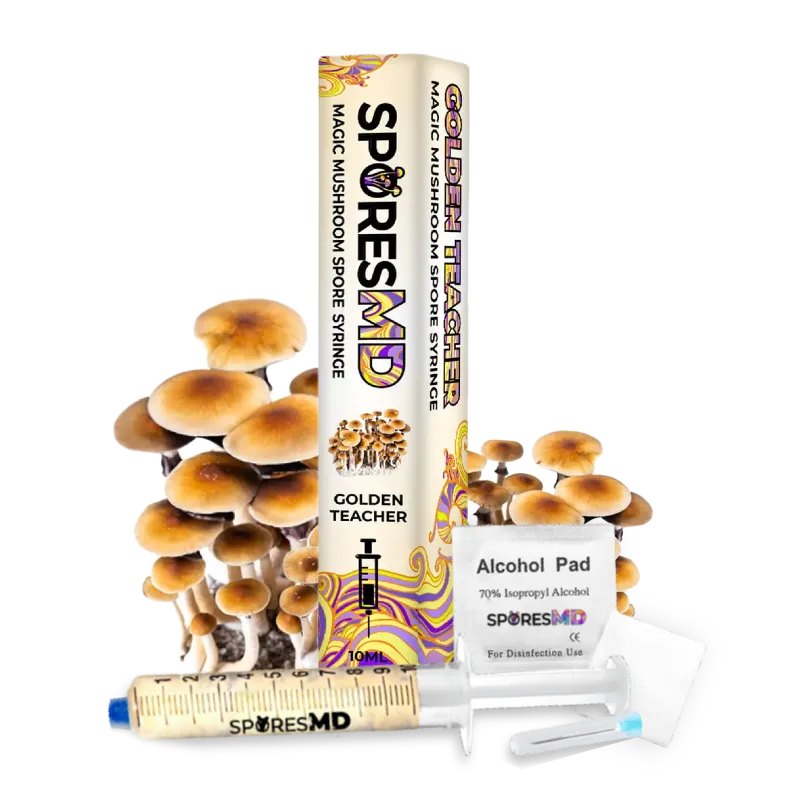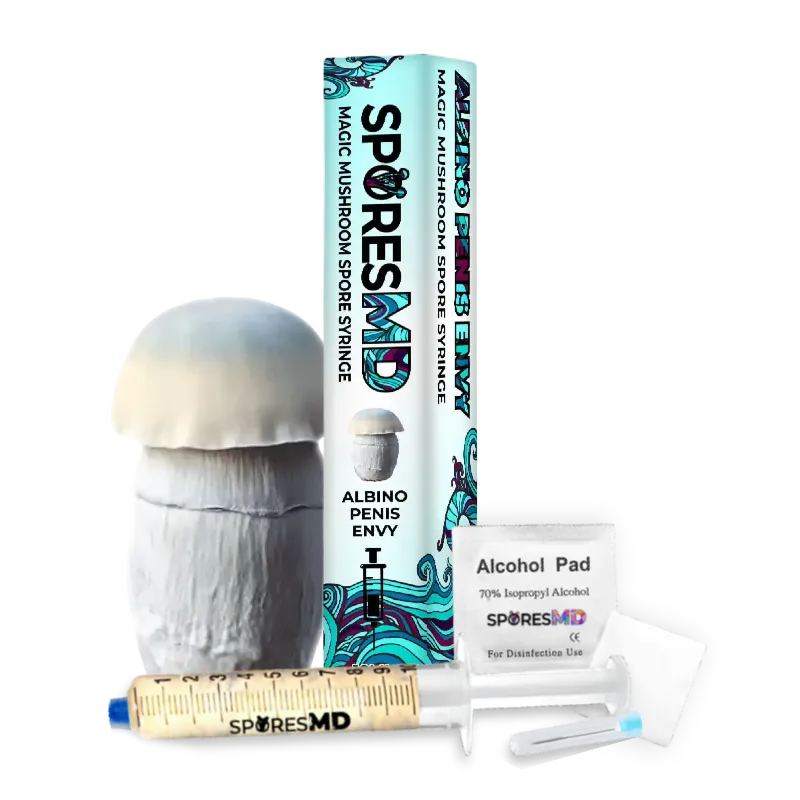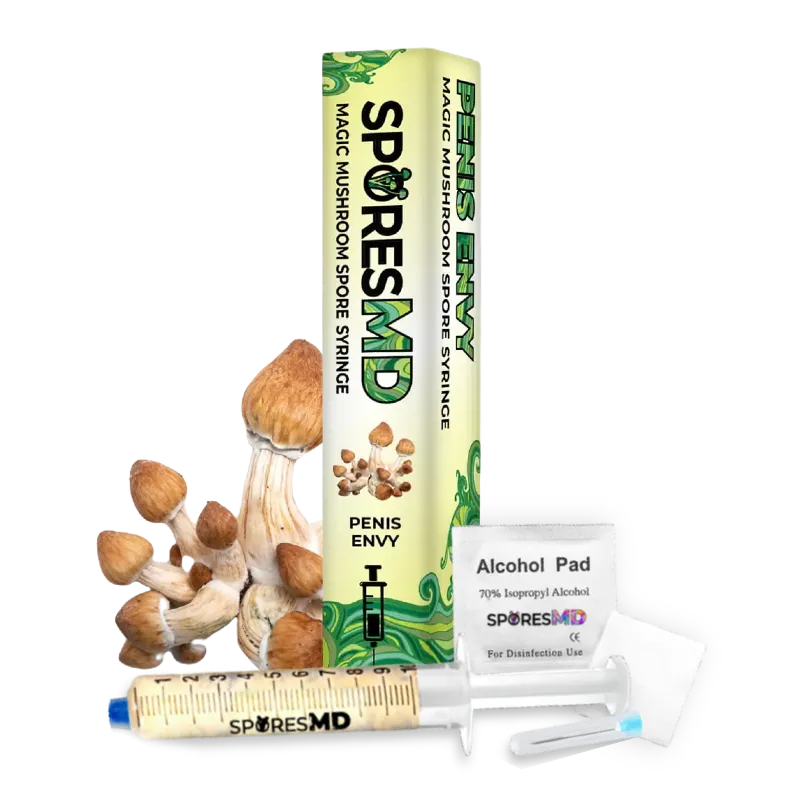So, you’ve got your hands on a spore syringes (be it psilocybe spores or gourmet spores), a nifty little container that’s your ticket to a world of mushroom growing. But once it’s in your possession, questions start to pop up. Where should you store it? How long will it last? And what’s this about freezing?
Don’t worry, we’ve got you covered. This article will shed light on the best practices for storing your spore syringes, ensuring they maintain their potency for as long as possible. We’ll delve into the ideal temperature and environmental conditions, the role of light exposure, and even discuss the age-old debate of spore syringes versus spore prints for long-term storage.
So let’s get started. It’s time to demystify the world of spore syringes and help you make the most out of your mushroom growing journey.
Key Takeaways
- Spore syringes, key elements in mushroom cultivation, need proper storage to ensure longevity and potency.
- Sterilization of spore syringes boosts their longevity, keeping them usable for indefinite periods.
- Appropriate storage conditions involve a cool, dark place with ideal refrigeration.
- Store spore prints in a dry, sterile container and refrigerate for maximized longevity.
- Avoid freezing spore syringes as it leads to water crystallization and damage to the spores, making them ineffective.
- Optimal storage conditions for spore syringes imply temperature control and moisture management.
- Techniques for storing spore syringes encompass sterility, refrigeration, use of airtight containers, and light avoidance.
- Assessing the quality of stored spore syringes includes visual and microscopic examination, rehydration before use, and tracing growth rate post-inoculation.
- Legal considerations attach to spore syringe storage in terms of understanding local laws, avoiding unlawful use, and adhering to clean trade regulations.
- Popular FAQs reveal that spore syringes should not be stored at room temperature, all mushroom spore types are refrigerator-safe, and appropriate packaging is needed for fridge storage.
Introduction
Spore syringes represent a crucial constituent in the cultivation of mushrooms and microscopy study. Get acquainted with their proper storage for prime results. Follow these steps to secure the viability of your spore syringes for an extended duration.
Step 1: Sterilize Your Spore Syringes
Treat your freshly harvested spore syringes with a sterilized spore-water solution. This sterilization step ensures the longevity of the syringes and keeps them usable for indefinite periods.
Step 2: Appropriate Storage Method
The storage method for your spore syringes depends on their intended use. Ready to use spore syringes for cultivation purposes within 60 days of harvest ensure the best results. Stored appropriately in a cool, dark place, spore syringes remain viable for years.
Step 3: Refrigeration
Retain the spore syringes in the sterile packaging they come in, and consider refrigeration. This prolongs their lifespan, especially for liquid culture syringes.
Step 4: Store Spore Prints
If you have spore prints, store them in a dry, sterile container. Like the syringes, spore prints also benefit from refrigeration. Be cautious about humidity, as it could be an enemy to their preservation.
Proper storage of spore syringes not only prolongs their use but also enhances the quality of mushrooms you grow. Adopt these storage methods and unlock the potential of your mushroom cultivation adventures.
The Importance of Proper Storage
Appreciate the vitality of properly tending to your spore syringes. Spore syringes, hosting microscopic mushroom seeds, are uniquely delicate. A clutter-free, temperature-stable environment guarantees their longevity. Forget not, an essential aid in mushroom cultivation and microscopy.
- Foster Sterility: A core tenet of mushroom cultivation, sterility, wards off contaminating organisms. Your SporesMD spore syringes come with a sterility guarantee for 30 days post-purchase. A breach in sterility disrupts their natural longevity, inhibiting fruitful research and cultivation.
- Refrigerate for Longevity: Spore syringes thrive in the cool environment of your refrigerator. The temperature aids their delicate live constituents to survive, extending their viability. A shelf in the middle, free from the daily disruptions of the door opening and shutting, ensures an optimum preservation spot.
- Store Spore Prints Correctly: Spore prints find more longevity when dried and stored in a cool, dark space. A parchment paper envelope or ziplock bag keeps them secure from contamination and moisture.
- Manage Use Based on Purpose: Harness the suitability of spore syringes to your purpose. Lowly-stocked syringes serve microscopy purposes aptly, coursing through slides with ease. For cultivation, syringes boast ample density, enabling you to inoculate substrates efficiently.
Heed these foundational steps, the pillars of spore syringe quality conservation. Herein lies your increased success in study and cultivation.
Optimal Conditions for Storing
To maximize the longevity and effectiveness of your spore syringes, understanding the optimal conditions for storage is crucial. This involves ensuring appropriate temperature control and moisture management.
Impact of Temperature Control on Storage
It is vital to store mushroom spores in a temperature-controlled environment. Aim for a cool setting, ideally between 35F (2C) and 50F (10C). This temperature range guarantees the durability and viability of the spores. Exposure to extreme heat or cold severely jeopardizes the fragile structure of the mushroom spores. Similarly, avoid temperature fluctuations, as they harm the integrity of the spores over time.
Necessity of Moisture Management
Moisture management is just as important as temperature control when storing mushroom spores. Use desiccants or drying agents like silica gel packs or oxygen absorbers to regulate moisture levels. These tools help maintain low humidity conditions that deter mold growth and degeneration of spore quality.
Whether you’re storing spore prints or syringes, an airtight container minimizes moisture exposure from the surroundings. This method ensures superior preservation for extended periods. Keep an eye out for any signs of condensation buildup in the stored containers. This could indicate unsuitable storage conditions that require immediate modification.
Long-term and Short-term Storage Methods
The question of how to store spore syringes depends on the intended duration. By properly storing these syringes, you can extend their shelf life and maintain their viability. Let’s delve into the specifics of both short-term and long-term storage techniques.
Techniques for Storing Syringes Before Use
Remember, sterility is vital. Throughout the storage process, avoid contamination. Doing so eliminates the risk of fungi other than your intended species growing in your cultivation medium.
- Refrigerate your syringes: Store your spore syringes in the refrigerator, rather than at room temperature. Keeping them cool extends their viability. The optimal storage temperature ranges between 35F (2C) and 50F (10C). Be sure not to freeze the syringes as this could destroy the spores.
- Use an airtight container: To minimize the exposure to moisture, utilize an airtight container for storage. Doing this helps in keeping the syringes dry and preventing any form of degradation.
- Avoid light exposure: UV light can damage the spores. Therefore, store the syringes in a dark place or container to protect them.
Tips for Repackaging Syringes After Use for Long-Term Storage
After using a spore syringe, remaining spores can be stored for later use. Here are some tips to properly repackage and store your syringe:
- Maintain sterility: Sterilize the needle before recapping the syringe after use. An alcohol wipe proves effective for this task. Sterility is paramount in preventing contamination.
- Store in the refrigerator: Just as with intended short-term storage, the refrigerator is the best place to store your used spore syringe. Properly refrigerated spore syringes have a long shelf life.
- Use a sealable bag: Store the syringe in a sealable bag. This adds a layer of protection and further shields the syringe from contamination.
- Label your syringes: If you’re working with different strains, labelling each syringe will prevent mix-ups later.
By following these storage methods, both before and after use, your spore syringes remain sterile and viable. Whether you intend to use them in a few days or several months, correctly storing your spores guarantees consistent and impressive results. Always remember that the longevity and effectiveness of your spore syringes largely depend on the care with which they’re handled and stored.
Why Freezing is Not Advisable
While refrigeration supports the longevity of spore syringes, freezing elicits adverse effects. Spore syringes preserve best at temperatures between 35F (2C) and 50F (10C). Above this range may foster bacteria, and below it can result in spore damage. When spores freeze, the water in their cells crystallizes. This expansion leads to cell wall rupture, rendering the spores ineffective.
*Beware of turning to your freezer for spore storage: *hastened spoilage, not prolonged freshness, awaits.
When looking for psilocybin mushroom spores or any other viable propagation materials, always aim to keep your storage methods optimal. Cold does not always translate to better in terms of spore conservation.
Remember, proper storage doesn’t simply entail focusing on refrigerator settings. It encompasses other factors such as moisture control, sterility, and light exposure. Make certain to use airtight containers to prevent excess moisture from infiltrating. Ensure your storage zone has minimal light exposure to protect the spores.
Common Mistakes
Your spore syringes require precise storage. An incorrect approach to storing your spore syringes could lead to contamination, decay, and utter disappointment. Myriad mistakes may occur in this process, and two chief pitfalls for beginners and veterans alike include excessive handling and improper labelling.
Risks of Excessive Handling
Facilitate minimal handling of your spore syringes. Prevalent misconceptions recommend constant checks and shake-ups. However, such overeager handling introduces air exposure with its eminent risks. One must not forget the possibility of spreading contamination on the syringe or breaking the needle. The rational approach entails safe storage post-acquisition until it is ready for use.
Example: Pipetting practices highlight the need for minimal handling. Too much handling could disturb the internal environment of the pipette and introduce contaminants. Much like this, spore syringes also require limited interference – store them securely and only handle them when necessary.
Importance of Proper Labelling and Identification
Mismanagement or misidentification of stored spore syringes can pose significant difficulties. Proper labeling proves a simple yet impactful solution. Relevant information such as strain name, inoculation date, and perhaps the source or even storage date might appear insignificant initially. Yet, in a flourishing storage scenario, keeping track of your varieties ensures straightforward planning and execution without needless confusion.
Example: Much like research labs label their test tubes to avoid cross-contaminations or misplacements, you can adopt a similar practice. Label your spore syringes correctly and prevent any strain mix-ups.
Adherence to these simple yet significant measures can make the difference in the fortitude and productivity of your spore syringes. Extend the longevity and reliability of your spore samples by avoiding these common pitfalls. Your practices shape your results, so make them count.
Harvesting and Collecting Spores
Take a firm grasp of the mushroom cultivation domain, and study the entire process of harvesting and collecting spores from spore syringes. Experience a joy while viewing spores at a magnification of 400x or higher, a practice that allows the accurate observation of the tiny life-factories.
- Prepare your solution: Combine small amounts of dried spores with water to create a microscopic spectacle. This distinct blending technique enhances visibility and understanding of the mushroom lifeline.
- Set up the slide: Drop an amount of this new solution onto a glass slide. Slip on a cover, securing it on top. Much like roofing a house, this prevents unwanted external conditions from affecting your specimen. Carefully absorb any excess water with a paper corner; akin to sealing the roof, this step ensures your cover slip remains stationary.
- Leverage your resources: Numerous solutions are available in hypodermic syringes aiding direct dispensing onto the slide. The convenience this alternative brings is invaluable, similar to preparing your favorite espresso shot.
- Measure the spores: Finally, full appreciation of size comes with knowledge, and for that, employ a stage micrometer. This tiny ruler engraved on a glass slide allows for precise sizing of spores. Like comparing coins of different denominations, this comparison establishes a greater understanding of the spore kingdom.
Step steadily into this microscopic world. Understand distinct features and attributes that define plant fertility. In this at-home lab, with little more than a slide and a syringe, your adventures into the mycological realm begin. Discover your passion for cultivating mushrooms right from the collection process.
Assessing the Quality of Stored Syringes
Move your scrutiny towards the stored spore syringes at this point. A proper examination of spore syringe quality reveals the effectiveness of your storage efforts.
Visual Inspection
- Observe the solution clarity. A clear, sediment-free solution indicates that spores were well-cleaned prior to storage. Consequent sprints of the syringe usually result in a cloud of tiny particles, which are actually floating mushroom spores.
- Check for discolouration. A change in the default colour of the solution or the appearance of dark patches might signify bacterial contamination.
Microscopic Examination
- Examine the spore shape and size. Distance your examination to the microscopic level. The specimen holds a wealth of information under the microscope, from spore shape, size, and structure, to the variability of these parameters, which provides us with a rich morphological profile of the mushroom strain.
- Check for mycelial contamination. Detect surrounding hyphae or budding yeast cells, indicative of potential mycelial contamination in your solution.
- Rehydrate before use. Stored spores require rehydration before inoculating any growth substrate. Dehydrated spore prints almost certainly curtail successful mycelia generation.
- Assess growth rate post-inoculation. The speed at which the mycelium colonizes your substrate vouchsafes for the vitality of your spores. Sluggish growth might be a red flag.
Post-storage assessments significantly enhance the success rate of subsequent inoculation and mushroom cultivation.
Legal Considerations
Necessity acts as the foundation for spore syringe storage. However, legal implications impact this process. These implications form an integral part of spore storage procedures.
- Understanding Local Laws: Laws governing the storage and usage of spore syringes vary significantly throughout various regions. In the United States, for example, psilocybin mushroom spores are legal except in Georgia, Idaho, and California for their potential to produce psilocybin mushrooms. Verify your local rulings to avoid legal repercussions.
- Avoiding Unlawful Use: It’s essential to remember that while the sale and possession of some strains are legal, their cultivation into mushrooms containing psilocybin may not be as it could violate local, federal, and state laws around psychotropic substances.
- Adhering to Clean Trade Regulations: Various regions enforce strict import/export regulatory conditions on bio-materials like spores, requiring stringent clean trade practices. To foster global bio-diversity, ensure the adherence to these regulations by proceeding only with authorized and legal transactions.
By understanding your obligations and anticipating potential legal barriers, you effectively navigate this delicate landscape while achieving your goals in accordance with local law. Following these steps, you maintain productivity while ensuring compliance with rules and regulations.
Legal matters are often tedious and complex but possess undeniable importance. Store and use your spore syringes responsibly, keeping yourself within the good graces of your local regulatory body.
Frequently Asked Questions
In this section, we respond to some common queries about storing spore syringes. Below are some frequently asked questions and their instant, direct answers.
Can Syringes be Stored at Room Temperature?
No. Room temperature might be excessive for spore syringes. Always store spore syringes in a cool and dark location. Protect them from direct sunlight, a large enemy of mushroom spores. The ideal location might be a refrigerator. There, spore syringes could last up to 12 years, significantly longer than at room temperature.
Are All Mushroom Spore Types Safe for Refrigeration?
Yes. Refrigeration is safe for all types of mushroom spore syringes. However, please note that freezing isn’t suitable. When water inside the syringes freezes, it expands, potentially damaging the syringes and rendering the spores unviable. As such, refrigeration – not freezing – ensures the longevity of your spore syringes.
How to Package Syringes for Fridge Storage?
Seal them tightly after use, and always ensure they are securely stored. You can place the spore syringes in zip-lock bags and cover them in foil for extra security. Remember to label each syringe with the strain of mushroom spores it contains and the date you received it. This practice helps in efficiently tracking your spore supplies over time. Then, store the syringes in the cooler parts of your fridge.
Make sure to provide them with the optimal storage conditions for maximum longevity and viability.
Conclusion
You’ve learned the ins and outs of storing a spore syringes. It’s clear that proper storage is key to successful mushroom cultivation and microscopy. Remember, refrigeration trumps freezing and correct packaging is a must. Don’t forget to label your supplies to keep track of them easily. Abiding by local laws and clean trade regulations is non-negotiable. So, you’re now equipped to maintain the longevity and viability of your spore syringes. Don’t hesitate to explore various psilocybe spore strains at SporesMD. With this knowledge, you’re well on your way to mastering the art of spore syringe storage. Here’s to your success in this fascinating field!

![How to Store Spore Syringes Effectively [5 Step Process]](https://sporesmd.com/wp-content/uploads/2024/04/GPFuFweLwi4b0BxYnWVP9.jpeg)



